Kona unit обзор
Обновлено: 04.07.2024
Although it’s yet to see its 20th birthday, the Unit might as well be a classic at this point. It’s been in Kona’s lineup since 2003 when it was released as one of the first production singlespeed mountain bikes on the market. It was (and kind of still is) Kona’s affordable, bare bones, cross-country-oriented, steel singlespeed staple. But it’s also something of an oddball niche experiment.
My first Kona Unit was a dark green 2010-ish fully rigid model. I bought it to punish myself after work a couple of times a week on our local suburban stacked singletrack. At that point in time, singlespeed mountain bikes were still a bit eclectic, though I suppose they always will be to the mainstream. Later, in 2016, Kona reinvented the Unit once more, again as a singlespeed. But this time it was adorned with mounts and provisions, and launched with a fantastic video featuring Erkki Putilla, an adventurous seafaring Norseman, who rode the Unit from his fishing boat into the Finnish forest for a simple, singlespeed bikepacking adventure. Building on this campaign’s success, Kona decided to stick gears on it and spin up a dedicated trail bikepacking version for 2018—the Unit X. Then, in 2020, it was revamped once again, and we were particularly excited about this model. Read on for a full review after several local overnighter trips, a lot of trail miles, and loads of…. gravel rides!?
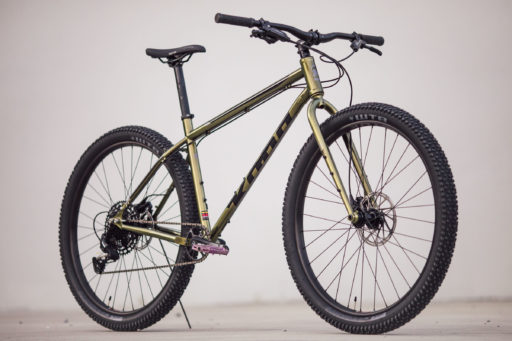
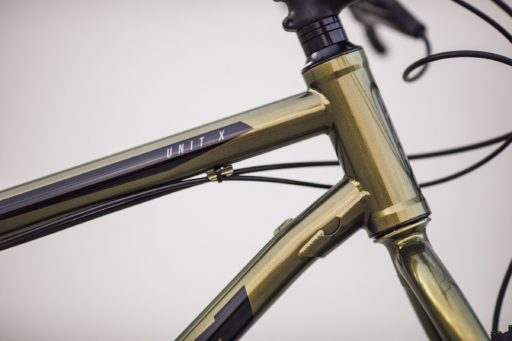

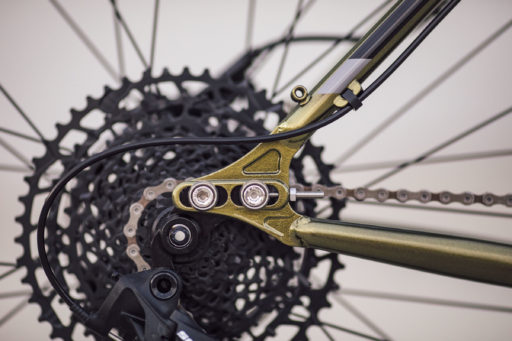
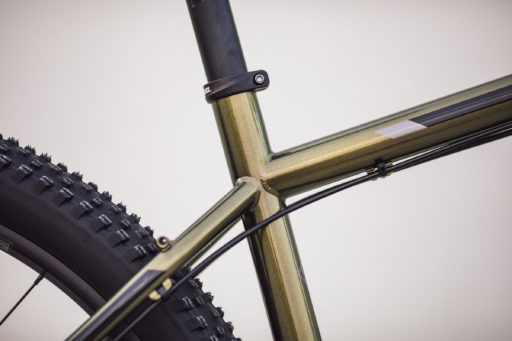
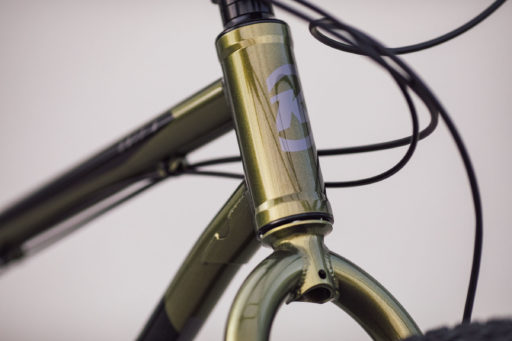
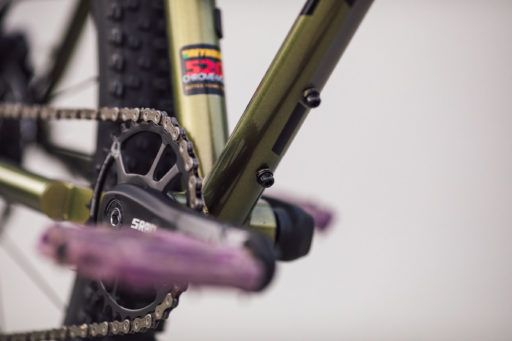
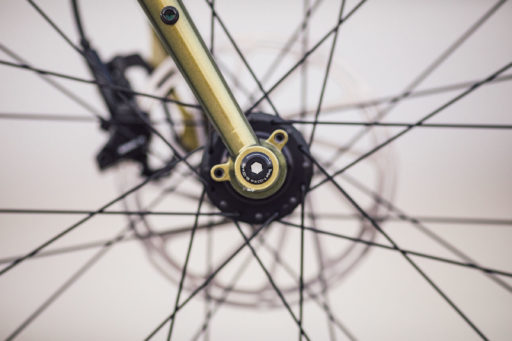
To preface, just a couple of weeks ago Kona announced its 2021 Kona Unit X. Fortunately for us, aside from a new paint job, it’s nearly identical to the 2020 model, which is what’s reviewed here. To that end, this review is still 100% relevant!
There were quite a few exciting changes made from the 2019 model to the 2020 Unit X. Aside from that blingy “Gloss Champagne” paint scheme, the most visible update was Kona’s switch from 27.5+ to 29 x 2.6″ tires, a move I happily stand behind. I’ve been riding 29 x 2.6″ tires almost exclusively on trail bikes and longer bikepacking trips for the last few years and have been pretty stoked on the platform. It offers a good mix of traction and floatation without taking as much of a penalty on sidewall support and weight that’s often evident in larger 29 x 2.8 or 3.0” rubber. To be sure, 29 x 2.6” tires are usually a little heavier than 27.5+ tires (about 100 grams per pair, on average), but the rollover benefits of 29er tires is bar none.
Kona also ditched the 100/135 quick-release dropout standards in favor of BOOST-spaced thru-axles (148 x 12mm rear and 110 x 15mm front). This was another major upgrade that not only allowed a shorter chain stay, it also provided a little more front and rear tire clearance—it now comfortably fits 29 x 2.8” tires (which I tried) and appears as if it will fit 3.0” tires as well.
However, the most significant alterations to the 2020 Kona Unit X come from a shift in the bike’s geometry. Following modern trail bike trends, the 2020 Kona Unit X got a little longer and slacker. For starters, the headtube angle was slackened by a degree (68°) and the seat tube was made a degree steeper (75°). This clearly follows in the footsteps of Kona’s renowned Honzo lineup, and both are welcome changes to give the bike a more stable ride on downhills and what I find to be a more comfortable climbing posture as well. The bike is also significantly longer. The top tube was lengthened by a hair and the wheelbase increased by about 2cm, as did the bike’s reach. The stack height also got about 2cm taller, which (although still comparably short) falls in line with its dirt-touring prowess to give it a slightly more upright stance and make it more comfortable during long days in the saddle.

Additional tweaks include a significantly shorter chainstay length (430mm, down from 442mm). Another interesting feature on the 2020 Kona Unit X’s Reynolds 520 chromoly frame is the rather unique, dual-slotted sliding rear dropout, which allows it to be set up as a single speed or with a Rohloff. And there are plenty of mounting options, including three bottle cage mounts on the triangle (two inside and one under the down tube), front and rear rack mounts, fender eyelets, and three-pack cargo cage mounts on each fork blade.
Kona also dropped the bottom bracket by about 5mm, which was nullified on the complete with the larger diameter 29 x 2.6″ tires. Here’s the full geometry chart for reference (in millimeters).
2020 Kona Unit X Build Kit
Highlights of the 2020 Kona Unit X include the relatively new SRAM Eagle SX drivetrain, which features a 11-50t cassette and a 32t chainring, yielding a 454% gear range and a relatively bikepacking-friendly 19 gear inches in the granny gear. Here’s the full build kit, with my opinions to follow.
I don’t have a lot of complaints about the Kona Unit X build as a whole. You certainly get a great bike for the price, and no matter how much you dissect the components, it’s definitely much more than a sum of its parts. However, for the sake of a review, there are a few issues I had with the build kit. My biggest gripe is the fact that it didn’t have a dropper post. WIth the Unit’s trail-worthy geometry, it only seems fitting. Of course, that might up the bottom line by $60, but it would be worth it. I put my 150mm Crank Brothers post on for the duration of the review period. Another quibble is the rather narrow handlebar—760mm is just a little too small for me and I would have preferred a 780mm bar, which is a little more common on trail bikes these days. Lastly, I experienced quite a bit of chain slap with the SX derailleur. It quickly became clear that the lowest-end Eagle cassette definitely suffers from a weak clutch. Wrapping the chainstay with an old innertube would solve this.
Otherwise, there are a few componentry specs that I really liked, such as the 180mm front brake rotor. Also, the WTB ST i30 rims and tubeless-ready WTB Ranger tires are a match made for bikepacking. I’ve always been a fan of the Rangers and really liked the 2.6” versions. They’re fast and still offer a surprising amount of traction.
On the Trail
I was quite anxious to get this bike out on our local rowdy and rooty trails. I don’t ride fully rigid bikes as much as I used to, but there’s always a soft spot in my heart for the genre, and an overt curiosity as to how well they’ll handle singletrack. The Unit X has a lot of good qualities that you see in other rigid steel trail bikes—think Surly Krampus and Tumbleweed Prospector—with a few modernized tricks, like a longer stance and steeper seat tube angle. On the trail, the Unit X felt very comfortable and stable. It was surprisingly sprightly, too, despite the fact that it weighs north of 30 pounds (31.1 to be exact, or 14.1kg). I’m not quite sure where the extra calories are on this bike, to be honest. Perhaps they just add up with heavier hubs, cockpit components, and lower grade parts and bits. But I definitely don’t think it’s a heavy tubeset. In fact, I was very impressed with how comfortable the Reynolds 520 frame felt. I wouldn’t say it was springy, but it’s clear that it’s not overbuilt. The rear end was more compliant and soft than other bikes I’ve tried recently. It was quite nice, zingy even, and kind of reminded me of my old Moonlit Swamp Krampus. With a lighter wheelset and a few parts upgrades, I have no doubt that it would feel all the more spritely and playful.
Unfortunately, I didn’t get to try the Unit X with a suspension fork. The frame is designed for a fork with 100mm of travel, which is a little small for my liking. Not to knock it before I try it, but if I had one wish for this bike, it’s that Kona would revamp it around a 120mm fork—that might just be perfection. I think you could easily get away with running a 120mm fork on it, but as intended, the frame’s 65mm bottom bracket drop gives it a nice in-the-bike feel and keeps it nimble in the corners, which I really liked. Bumping up to a longer fork might tarnish those qualities a little.
Following in the footsteps of the Sutra LTD, the Unit has a surprisingly low stack height for a dirt-touring rig. This firmly planted the front wheel, and coupled with the Unit X’s relatively heavy build, made it a little challenging to lift up the front end at times. Even so, like the Sutra LTD, I felt like the Unit X was very well balanced. And, the shorter fork, low stack, and steep seat tube gave it an ibex-like climbing prowess. There’s one local downhill that I like to occasionally ride in reverse on weekday afternoons. It has two super steep pitches with roots and rocks that require some finesse to clear. It’s not uncommon that I make it over one of them and spin out on the other. The two times I climbed it with the Unit I cleared both pitches. It’s also comfortable and efficient in the climbing position, both on steep technical climbs, and even on longer dirt road and gravel ascents.
Speaking of gravel, as the title suggests, there were multiple occasions when I was preparing to roll out on a gravel/doubletrack ride, and I grabbed the Kona Unit X over three drop-bar bikes that I had at my disposal. Despite its chunky 31-pound weight, it simply felt at home on these types of rides. It tracked beautifully, felt incredibly stable, and it was quite fast, too. Moreover, it simply felt comfortable. The relatively long geometry and steep seat tube fit me well and weren’t at all tiring to pedal for long rides.
While Out Bikepacking
Barring a couple of caveats, the previous two paragraphs adequately summarize why I think the Unit X makes a great dirt-touring bike. Namely, it checks off a lot of mandatory provisos that are required of a bike for such a task: speed, stability, comfort, versatility, and the “at home” feel that’s priceless for a bike that will be ridden day in and day out on a long tour.
During the overnighter bikepacking trips I took with the Unit X, it performed as expected. I suppose there are some caveats. Namely, I would prefer the rack mounts to be a hair lower on the seat stays. Not a deal breaker, but something I noticed. Also, on one particular bike-glamping trip when I was carrying a camp chair, a six-pack of beer, too much food, and fishing gear, along with a lot of other extras, I noticed that the frame felt a little on the flexy/noodly side. Really, this is another non-issue as I think the tubeset is really well balanced for trail riding and bikepacking, but if you’re thinking of a bike that can be loaded with four panniers and a full touring load, this might not be the one.
- Incredibly versatile geometry that’s equally at home on the trail as it is on gravel roads
- Great value for the complete
- Slotted dropouts can be used for singlespeed or IGH conversion
- Minor build kit gripes, including narrow 760mm handlebars, no dropper post, and shoddy Eagle SX derailleur that doesn’t work so well with a small chainring due to its weak clutch
Wrap Up
The Kona Unit has always been something of an enigma, and as Kona suggests, it’s a bike they’ve kept in their lineup because people liked it for a lot of unknown reasons. Whether you see the Kona Unit X as some sort of an adventure rig, a do-all bike, or a cult favorite rigid steel oddball, you’re exactly right. It’s a bike that can’t be pigeonholed and truly works well for a lot of different surfaces and scenarios. If you want to ride the Unit X on a long stretch of backcountry gravel while taking in scenery, it’s quite comfortable and tracks extremely well. And if you want to get loose on chunky singletrack, it won’t disappoint there either.
Generally speaking, I had some minor gripes with the build kit, but overall it’s pretty solid, and I wouldn’t hesitate to take it as is on a dirt tour almost anywhere. It’s a little hefty on the scales, but for $1,400 it’s a pretty good deal. If Kona kept that price tag and threw in a dropper post, it would be even sweeter. Either way, the Unit X remains one of the more affordable, well-appointed options on the market. Most of all, rigidx steel bikes like the Kona Unit X epitomize how bikepacking rigs came to be, and Kona made a lot of excellent changes that represent how these bikes should continue to evolve.
Войти
Авторизуясь в LiveJournal с помощью стороннего сервиса вы принимаете условия Пользовательского соглашения LiveJournal
Отзыв о велосипеде Kona Unit от Криса Бэкхауса
Отзыв о велосипеде Kona Unit. Куплен Крисом Бэкхаусом в магазине Michael’s Cycles в Прайор Лейк, штат Миннесота, в октябре 2012 года.
Я слышал выражение «меньше знаешь – крепче спишь». Но лично я не хотел бы оставаться в неведении. Я люблю знать, что происходит, контролировать ситуацию, люблю чувство уверенности. Для меня знания – сила, а в силе рождается гордость за то, что ты делаешь.
За те тысячи часов, которые я провел, колеся по трейлам и синглтрекам на своем байке Trek, у меня появилось чувство огромной гордости за себя. После двух лет без катания я вернулся в любимый спорт и понял, как мало я знаю. В попытке перейти от философии «меньше знаешь – крепче спишь» к философии «будь проще» я распродал остатки спортивного прошлого и купил новый байк в надежде на новое будущее без лишних сложностей.
Встречайте Kona Unit, отмороженный на все сто, жесткий односкоростной байк из легированной стали с 29-дюймовыми колесами. Он создан компанией, которая стремится расширить рамки доступного и сохранить уникальность в мире многоскоростных байков и амортизированных вилок. Она совершила настоящее чудо для относительно небольшой группы райдеров, которые мечтают о новом простом будущем без вилок, лишних звезд и прочего балласта – она сделала это для таких, как я.
Если я что-то и уяснил для себя при езде на жестком односкоростном велосипеде – это то, что тормоза придуманы для трусов. Жесткий односкоростной байк – это настоящее воплощение беспощадности, он благосклонен только к самым оторванным байкерам. Он не прощает ошибок на крутых спусках и безжалостно бросает неподготовленных байкеров в пучины нового опыта, который меняет не только тело, но и душу, помогая вам стать одним целым с байком. Весь смысл – в особой связи между байкером и этой простой машиной. Но в случае с Kona Unit дело еще и в подчинении. Вы не сможете заставить этот байк играть по вашим правилам. Я пытался, и у меня ничего не получилось. Вместо этого его страсть к острым ощущениям захватила меня с головой. Он требует от вас отдачи, полной отдачи, без остатка, а взамен дает только чувство азарта в то время как вы едете на пределе способностей и сил. Unit заставляет вас балансировать на грани между контролем и неуправляемостью, осторожностью и безответственностью, разумом и безумием. Этот байк выжмет из вас все соки и оставит на обочине обессиленным, мечтающим уйти и жаждущим продолжения. Этот байк не заставить играть по вашим правилам. Единственный выбор – проглотить гордость (или глупость?) и преклониться перед его превосходством. Тогда и только тогда, когда ваша воля подчинится этому байку, вы познаете настоящее блаженство. Этот байк приглашает вас испытать себя: «Отдай мне свою волю, и я дам тебе то, о чем ты мечтаешь». Этот байк не просит – он требует.
Сначала я собирался дать ему имя. Но уже при первой поездке байк однозначно дал мне понять, что у него есть имя, его зовут Unit, и по-другому его не назвать. Да здравствует будущее без лишних сложностей. Unit, я принимаю твой вызов: посмотрим, кто кого.

Kona Unit X 2020 - шаг через ступеньку на пологой спирали эволюции. Для ориентира - прошлогодняя заметка про текущую модель . Тем, кому лень читать многабукаф, сводка того, что изменилось:
базовая размерность колёс - 29x2.6" на ободах 30 мм против 27.5x2.8" на ободах 35 мм;
оси Boost 148x12 мм+110x15 мм против QR 135x10 мм+100x9 мм;
Немного простыми словами про изменения в геометрии: посадка растянулась, положение рук стало выше. Подъём переднего колеса над препятствием - легче. Стабильность на ходах должна увеличиться, поворачиваемость - сохраниться. Хочется надеяться, что так оно и будет - тест покажет.
Картинка скопипащена из ценного материала про резину для сверхдальних маршрутов. Нас в ней интересует вторая справа иконка, посвящённая ровно нашей ситуации: резина 29x2.6" на ободах 30 мм обладает весьма близким внешним диаметром с 27.5x2.8" на ободах 35 мм, но преодолевает препятствия лучше. За счёт бОльшей площади пятна контакта. Дальше начинается къибениматика: пара покрышек WTB Ranger TCS 29x2.6", увы, на 600 граммов тяжелее, чем 27.5x2.8", но обода i30 экономят 100 граммов. Итого, проигрыш - пол-кило на велосипед. НО! меньше подламывания в поворотах, уводов. В той же статейке можно подглядеть варианты резины полегче для дальнейшего тюнинга.
Ещё один пункт рассуждений про геометрию и шины порадует павианов с илитного велоресурса: провис каретки на Kona Unit X 2020 на 5 мм больше (устойчивость на дуге поворота), но клиренс при штатных покрышках на 10 мм больше. Если же вы используете Unit в походе по твёрдым грунтам, то вполне можете, например, поставить колёсную пару со своего ХС-велосипеда, оставив дорожный просвет на уровне модели прошлого года.
Таким образом, если сборка на предыдущем варианте рамы ориентировалась на запасы под кроватью (эксцентрики, 135-я задняя втулка. ), то нынешняя прямо апеллирует к стандартам сегодняшнего дня.
Возможность использования резины вплоть до 27.5x3.0" на ободах 40 мм для всевозможных слабонесущих грунтов сохранена.
Пройдёмся по базовым ценностям Kona Unit (замечу, намеренно опустил X, ибо решения едины). На фото мы видим скользящие дропауты, с 2020 переделанные, наконец, под ось ø12 мм. В варианте с классическим переключателем, они позволяют тонко настраивать длину нижних перьев. Или дать пару лишних миллиметров зазора пяткам - при использовании бортовых багажных мешков. Про варианты багажников, компенсирующих короткие перья, см. сюда . Разумеется, интегрированные тормозные адаптеры - стандарта РМ - надёжность, ремонтопригодность.
Один из вариантов игры в долгую - замена стандартной трансмиссии на Rohloff Speedhub A12-148 - вам не нужны никакие дополнительные устройства натяжения цепи.
Материал рамы - классические баттированные хром-моли трубы Reynolds 520 - не пушинка, не Hi-End, но очень надёжно. Не стоит ждать именно от рамы выдающихся амортизационных свойств. За это отвечает резина большого объёма.
Обратите внимание на лючок - заглушка под потенциальный дроппер-пост. ø31.6 мм - очень хороший размер с массой вариантов. Кстати, вся остальная проводка идёт снаружи, закреплена удобными и красивыми зажимами - надёжность и ремонтопригодность.
Похоже, единственное место, где к трубам рамы был применен трубогиб. Узел остался в наследство с предыдущих лет. Просто и надёжно. Оцените качество краски и сварных швов!
Как удалось укоротить перья, добиться серьёзного грязевого зазора без изгиба подседельной трубы?
Начали про каретку - ей и продолжим. После долгих лет скрипов и щелчков возобладал разум - в раме Kona Unit X использована резьбовая посадка BSA. Но, дабы служба мёдом не казалась, сама каретка - стандарта SRAM DUB со специфическим диаметром вала 28,99 мм.
Трансмиссия - результат распространения идеи SRAM 1х12 в средне-бюджетный сегмент. SX-Eagle использует кассету 11-50Т и ведущую звезду 32Т - не самый быстрый, но ориентированный на крутые подъёмы и тяжёлые грунты вариант. Ещё недавно на одноклассники ставилась кассета 11-42Т 11 sp и ведущая на 28Т.
Тормоза - SRAM Level T с роторами ø160 и 180 мм соответственно. Просто. Кондово. Мощный хомут. Давно не катал, не могу ничего внятного доложить. Со времён Elixir не слишком люблю.
Пожалуй, из всех вариантов крепления груза и крыльев, на этом велосипеде не хватает только пары бонок под сумочку в передней-верхней части горизонтальной трубы.
Вот все таки как понять переход с 27.5 на 29 ? Почему не оставить версию с 27.5 колесами?

Another major update is the dropout standards. Kona ditched 100/135 QR in favor of BOOST-spaced thru-axles (148 x 12mm rear and 110 x 15mm front). This not only allowed them to shorten the chain stay, it also gives the bike what appears to be a little more tire clearance, both front and rear. We have a question out to Kona regarding the max clearance and will update this once we find out.
Читайте также:

